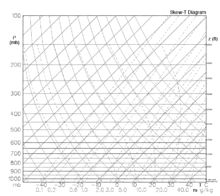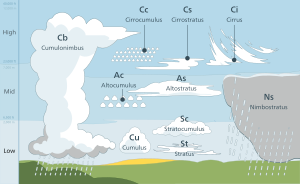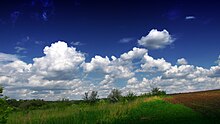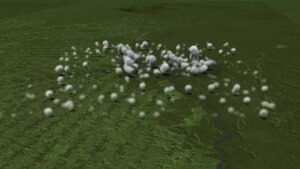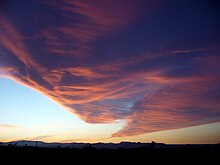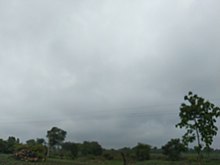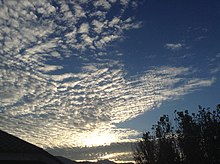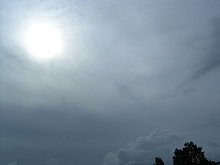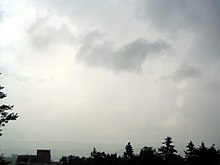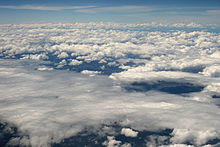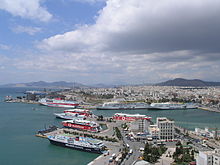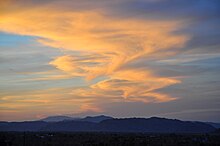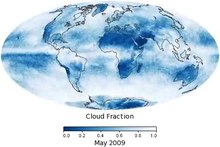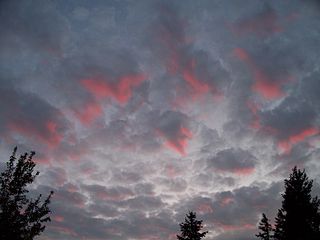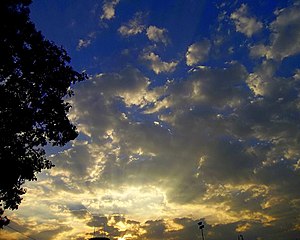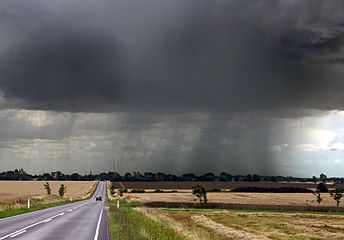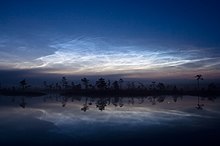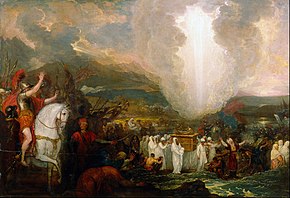From Wikipedia, the free encyclopedia
In meteorology, a cloud is an aerosol consisting of a visible mass of minute liquid droplets, frozen crystals, or other particles suspended in the atmosphere of a planetary body or similar space. Water or various other chemicals may compose the droplets and crystals. On Earth, clouds are formed as a result of saturation of the air when it is cooled to its dew point, or when it gains sufficient moisture (usually in the form of water vapor) from an adjacent source to raise the dew point to the ambient temperature.
They are seen in the Earth's homosphere, which includes the troposphere, stratosphere, and mesosphere. Nephology is the science of clouds, which is undertaken in the cloud physics branch of meteorology. There are two methods of naming clouds in their respective layers of the homosphere, Latin and common.
Genus types in the troposphere, the atmospheric layer closest to Earth's surface, have Latin names due to the universal adoption of Luke Howard's nomenclature
that was formally proposed in 1802. It became the basis of a modern
international system that divides clouds into five physical forms which can be further divided or classified into altitude levels to derive ten basic genera. The main representative cloud types for each of these forms are stratus, cirrus, stratocumulus, cumulus, and cumulonimbus. Low-level clouds do not have any altitude-related prefixes. However mid-level stratiform and stratocumuliform types are given the prefix alto- while high-level variants of these same two forms carry the prefix cirro-.
Genus types with sufficient vertical extent to occupy more than one
level do not carry any altitude related prefixes. They are classified
formally as low- or mid-level depending on the altitude at which each
initially forms, and are also more informally characterized as multi-level or vertical. Most of the ten genera derived by this method of classification can be subdivided into species and further subdivided into varieties. Very low stratiform clouds that extend down to the Earth's surface are given the common names fog and mist, but have no Latin names.
In the stratosphere and mesosphere, clouds have common names for
their main types. They may have the appearance of stratiform veils or
sheets, cirriform wisps, or stratocumuliform bands or ripples. They are
seen infrequently, mostly in the polar regions of Earth. Clouds have
been observed in the atmospheres of other planets and moons in the Solar System and beyond. However, due to their different temperature characteristics, they are often composed of other substances such as methane, ammonia, and sulfuric acid, as well as water.
Tropospheric clouds can have a direct effect on climate change
on Earth. They may reflect incoming rays from the sun which can
contribute to a cooling effect where and when these clouds occur, or
trap longer wave radiation that reflects back up from the Earth's
surface which can cause a warming effect. The altitude, form, and
thickness of the clouds are the main factors that affect the local
heating or cooling of Earth and the atmosphere. Clouds that form above
the troposphere are too scarce and too thin to have any influence on
climate change. Clouds are the main uncertainty in climate sensitivity.
Tabular overview
The
table that follows is very broad in scope. It draws from several
methods of cloud classification, both formal and informal, used in
different levels of the Earth's homosphere by a number of cited
authorities, especially with respect to forms, altitude levels, forms and levels, towering vertical clouds, and clouds above the troposphere.
Despite some differences in nomenclature, the classification schemes
seen in this article can be combined by using an informal
cross-classification of physical forms and altitude levels to derive the
10 tropospheric genera, the fog and mist that forms at surface level,
and several additional major types above the troposphere. The cumulus
genus includes four species that indicate vertical size which can affect
the altitude levels. This table should not be seen as a strict or
singular classification, but as an illustration of how various
major cloud types are related to each other and defined through a full
range of altitude levels from Earth's surface to the "edge of space."
For another tabular overview that also covers the entire
homosphere, see Cloud genera and selected species, supplementary
features, and other airborne hydrometeors (located just below the bottom
of the article).
Altocumulus over Monterrey, Mexico.
Time-lapse video of clouds at sunset in
JapanEtymology and history of cloud science and nomenclature
Etymology
The origin of the term "cloud" can be found in the Old English words clud or clod,
meaning a hill or a mass of stone. Around the beginning of the 13th
century, the word came to be used as a metaphor for rain clouds, because
of the similarity in appearance between a mass of rock and cumulus heap
cloud. Over time, the metaphoric usage of the word supplanted the Old
English weolcan, which had been the literal term for clouds in general.
Aristotle
Cumulonimbus thunder cloud
Ancient cloud studies were not made in isolation, but were observed in combination with other weather elements and even other natural sciences. Around 340 BC, Greek philosopher Aristotle wrote Meteorologica,
a work which represented the sum of knowledge of the time about natural
science, including weather and climate. For the first time,
precipitation and the clouds from which precipitation fell were called
meteors, which originate from the Greek word meteoros, meaning 'high in the sky'. From that word came the modern term meteorology, the study of clouds and weather. Meteorologica
was based on intuition and simple observation, but not on what is now
considered the scientific method. Nevertheless, it was the first known
work that attempted to treat a broad range of meteorological topics in a
systematic way, especially the hydrological cycle.
First comprehensive classification
Tropospheric
cloud classification by altitude of occurrence: Multi-level and
vertical genus-types not limited to a single altitude level include
nimbostratus, cumulonimbus, and some of the larger cumulus species.
After centuries of speculative theories about the formation and
behavior of clouds, the first truly scientific studies were undertaken
by Luke Howard in England and Jean-Baptiste Lamarck
in France. Howard was a methodical observer with a strong grounding in
the Latin language, and used his background to classify the various
tropospheric cloud types during 1802. He believed that the changing
cloud forms in the sky could unlock the key to weather forecasting.
Lamarck had worked independently on cloud classification the same year
and had come up with a different naming scheme that failed to make an
impression even in his home country of France
because it used unusual French names for cloud types. His system of
nomenclature included 12 categories of clouds, with such names as
(translated from French) hazy clouds, dappled clouds, and broom-like
clouds. By contrast, Howard used universally accepted Latin, which
caught on quickly after it was published in 1803. As a sign of the popularity of the naming scheme, German dramatist and poet Johann Wolfgang von Goethe
composed four poems about clouds, dedicating them to Howard. An
elaboration of Howard's system was eventually formally adopted by the
International Meteorological Conference in 1891.
This system covered only the tropospheric cloud types, but the
discovery of clouds above the troposphere during the late 19th century
eventually led to the creation of separate classification schemes using
common names for these very high clouds, which were still broadly
similar to some cloud forms identified in the troposphere.
Formation in the homosphere: How air becomes saturated
Terrestrial clouds can be found throughout most of the homosphere,
which includes the troposphere, stratosphere, and mesosphere. Within
these layers of the atmosphere, air can become saturated as a result of being cooled to its dew point or by having moisture added from an adjacent source. In the latter case, saturation occurs when the dew point is raised to the ambient air temperature.
Adiabatic cooling
Adiabatic cooling
occurs when one or more of three possible lifting agents – convective,
cyclonic/frontal, or orographic – cause a parcel of air containing
invisible water vapor to rise and cool to its dew point, the temperature
at which the air becomes saturated. The main mechanism behind this
process is adiabatic cooling.
As the air is cooled to its dew point and becomes saturated, water
vapor normally condenses to form cloud drops. This condensation normally
occurs on cloud condensation nuclei such as salt or dust particles that are small enough to be held aloft by normal circulation of the air.
Animation of cloud evolution from cumulus humilis to cumulonimbus capillatus incus
One agent is the convective upward motion of air caused by daytime solar heating at surface level. Airmass instability allows for the formation of cumuliform clouds that can produce showers if the air is sufficiently moist.
On moderately rare occasions, convective lift can be powerful enough to
penetrate the tropopause and push the cloud top into the stratosphere.
Frontal and cyclonic lift occur when stable air is forced aloft at weather fronts and around centers of low pressure by a process called convergence. Warm fronts
associated with extratropical cyclones tend to generate mostly
cirriform and stratiform clouds over a wide area unless the approaching
warm airmass is unstable, in which case cumulus congestus or
cumulonimbus clouds are usually embedded in the main precipitating cloud
layer. Cold fronts
are usually faster moving and generate a narrower line of clouds, which
are mostly stratocumuliform, cumuliform, or cumulonimbiform depending
on the stability of the warm airmass just ahead of the front.
Windy evening
twilight enhanced by the Sun's angle, can visually mimic a
tornado resulting from orographic lift
A third source of lift is wind circulation forcing air over a physical barrier such as a mountain (orographic lift).
If the air is generally stable, nothing more than lenticular cap clouds
form. However, if the air becomes sufficiently moist and unstable,
orographic showers or thunderstorms may appear.
Non-adiabatic cooling
Along
with adiabatic cooling that requires a lifting agent, three major
nonadiabatic mechanisms exist for lowering the temperature of the air to
its dew point. Conductive, radiational, and evaporative cooling require
no lifting mechanism and can cause condensation at surface level
resulting in the formation of fog.
Adding moisture to the air
Several
main sources of water vapor can be added to the air as a way of
achieving saturation without any cooling process: water or moist ground, precipitation or virga, and transpiration from plants
Classification: How clouds are identified in the troposphere
Tropospheric classification is based on a hierarchy of categories with physical forms and altitude levels at the top.
These are cross-classified into a total of ten genus types, most of
which can be divided into species and further subdivided into varieties
which are at the bottom of the hierarchy.
Physical forms
Clouds in the troposphere assume five physical forms based on
structure and process of formation. These forms are commonly used for
the purpose of satellite analysis. They are given below in approximate ascending order of instability or convective activity.
Stratiform
Nonconvective stratiform clouds appear in stable airmass conditions and, in general, have flat, sheet-like structures that can form at any altitude in the troposphere. The stratiform group is divided by altitude range into the genera cirrostratus (high-level), altostratus (mid-level), stratus (low-level), and nimbostratus (multi-level). Fog is commonly considered a surface-based cloud layer.
The fog may form at surface level in clear air or it may be the result
of a very low stratus cloud subsiding to ground or sea level.
Conversely, low stratiform clouds result when advection fog is lifted above surface level during breezy conditions.
Stratocumulus over Orange County.
Cirriform
Cirriform clouds in the troposphere are of the genus cirrus
and have the appearance of detached or semimerged filaments. They form
at high tropospheric altitudes in air that is mostly stable with little
or no convective activity, although denser patches may occasionally show
buildups caused by limited high-level convection where the air is partly unstable. Clouds resembling cirrus can be found above the troposphere but are classified separately using common names.
Stratocumuliform
Clouds of this structure have both cumuliform and stratiform characteristics in the form of rolls, ripples, or elements. They generally form as a result of limited convection in an otherwise mostly stable airmass topped by an inversion layer.
If the inversion layer is absent or higher in the troposphere,
increased airmass instability may cause the cloud layers to develop tops
in the form of turrets consisting of embedded cumuliform buildups. The stratocumuliform group is divided into cirrocumulus (high-level), altocumulus (mid-level), and stratocumulus (low-level).
Cumulus over Dooars, West Bengal, India
Cumuliform
Cumuliform clouds generally appear in isolated heaps or tufts. They are the product of localized but generally free-convective
lift where no inversion layers are in the troposphere to limit vertical
growth. In general, small cumuliform clouds tend to indicate
comparatively weak instability. Larger cumuliform types are a sign of
greater atmospheric instability and convective activity. Depending on their vertical size, clouds of the cumulus genus type may be low-level or multi-level with moderate to towering vertical extent.
Cumulonimbiform
Cumulonimbus cloud over the Gulf of Mexico in Galveston, Texas
The largest free-convective clouds comprise the genus cumulonimbus, which have towering vertical extent. They occur in highly unstable air and often have fuzzy outlines at the upper parts of the clouds that sometimes include anvil tops. These clouds are the product of very strong convection that can penetrate the lower stratosphere.
Levels and genera
Tropospheric clouds form in any of three levels (formerly called étages) based on altitude range above the Earth's surface. The grouping of clouds into levels is commonly done for the purposes of cloud atlases, surface weather observations, and weather maps. The base-height range for each level varies depending on the latitudinal geographical zone. Each altitude level comprises two or three genus-types differentiated mainly by physical form.
The standard levels and genus-types are summarised below in
approximate descending order of the altitude at which each is normally
based.
Multi-level clouds with significant vertical extent are separately
listed and summarized in approximate ascending order of instability or
convective activity.
High-level
High clouds form at altitudes of 3,000 to 7,600 m (10,000 to 25,000 ft) in the polar regions, 5,000 to 12,200 m (16,500 to 40,000 ft) in the temperate regions, and 6,100 to 18,300 m (20,000 to 60,000 ft) in the tropics. All cirriform clouds are classified as high, thus constitute a single genus cirrus (Ci). Stratocumuliform and stratiform clouds in the high altitude range carry the prefix cirro-, yielding the respective genus names cirrocumulus (Cc) and cirrostratus
(Cs). If limited-resolution satellite images of high clouds are
analysed without supporting data from direct human observations,
distinguishing between individual forms or genus types becomes
impossible, and they are collectively identified as high-type (or informally as cirrus-type, though not all high clouds are of the cirrus form or genus).
A large field of cirrocumulus
- These are mostly fibrous wisps of delicate, white, cirriform, ice crystal clouds that show up clearly against the blue sky.
Cirrus are generally non-convective except castellanus and floccus
subtypes which show limited convection. They often form along a high
altitude jetstream
and at the very leading edge of a frontal or low-pressure disturbance
where they may merge into cirrostratus. This high-level cloud genus does
not produce precipitation.
- This is a pure white high stratocumuliform layer of limited
convection. It is composed of ice crystals or supercooled water droplets
appearing as small unshaded round masses or flakes in groups or lines
with ripples like sand on a beach.
Cirrocumulus occasionally forms alongside cirrus and may be accompanied
or replaced by cirrostratus clouds near the leading edge of an active
weather system. This genus-type occasionally produces virga,
precipitation that evaporates below the base of the cloud.
- Cirrostratus is a thin nonconvective stratiform ice crystal veil that typically gives rise to halos caused by refraction of the sun's rays. The sun and moon are visible in clear outline.
Cirrostratus does not produce precipitation, but often thickens into
altostratus ahead of a warm front or low-pressure area, which sometimes
does.
Mid-level
Sunrise scene giving a shine to an altocumulus stratiformis perlucidus cloud (see also 'species and varieties')
Nonvertical clouds in the middle level are prefixed by alto-, yielding the genus names altocumulus (Ac) for stratocumuliform types and altostratus
(As) for stratiform types. These clouds can form as low as 2,000 m
(6,500 ft) above surface at any latitude, but may be based as high as
4,000 m (13,000 ft) near the poles, 7,000 m (23,000 ft) at midlatitudes,
and 7,600 m (25,000 ft) in the tropics.
As with high clouds, the main genus types are easily identified by the
human eye, but distinguishing between them using satellite photography
alone is not possible. When the supporting data of human observations
are not available, these clouds are usually collectively identified as middle-type on satellite images.
- This is a midlevel cloud layer of limited convection that is
usually appears in the form of irregular patches or more extensive
sheets arranged in groups, lines, or waves.
Altocumulus may occasionally resemble cirrocumulus, but is usually
thicker and composed of a mix of water droplets and ice crystals, so the
bases show at least some light-grey shading. Altocumulus can produce virga, very light precipitation that evaporates before reaching the ground.
Altostratus translucidus near top of photo merging into altostratus opacus near bottom
- Altostratus is a midlevel opaque or translucent nonconvective
veil of grey/blue-grey cloud that often forms along warm fronts and
around low-pressure areas. Altostratus is usually composed of water
droplets, but may be mixed with ice crystals at higher altitudes.
Widespread opaque altostratus can produce light continuous or
intermittent precipitation.
Low-level
Low clouds are found from near the surface up to 2,000 m (6,500 ft).
Genus types in this level either have no prefix or carry one that
refers to a characteristic other than altitude. Clouds that form in the
low level of the troposphere are generally of larger structure than
those that form in the middle and high levels, so they can usually be
identified by their forms and genus types using satellite photography
alone.
Stratocumulus stratiformis perlucidus over
Galapagos,
Tortuga Bay (see also 'species and varieties')
- Genus stratocumulus (Sc):
- This genus type is a stratocumuliform cloud layer of limited
convection, usually in the form of irregular patches or more extensive
sheets similar to altocumulus but having larger elements with
deeper-gray shading.
Stratocumulus is often present during wet weather originating from
other rain clouds, but can only produce very light precipitation on its
own.
- Genus cumulus (Cu); species humilis – little vertical extent:
- These are small detached fair-weather cumuliform clouds that
have nearly horizontal bases and flattened tops, and do not produce rain
showers.
Stratus nebulosus translucidus
- This is a flat or sometimes ragged nonconvective stratiform type that sometimes resembles elevated fog. Only very weak precipitation can fall from this cloud, usually drizzle or snow grains.
When a very low stratus cloud subsides to surface level, it loses its
Latin terminology and is given the common name fog if the prevailing
surface visibility is less than 1 km. If the visibility is 1 km or higher, the visible condensation is termed mist.
Multi-level or moderate vertical
Deep
multi-level nimbostratus cloud covering the sky with a scattered layer
of low stratus fractus pannus (see also 'species' and 'supplementary
features' sections)
These clouds have low- to mid-level bases that form anywhere from
near the surface to about 2,400 m (8,000 ft) and tops that can extend
into the mid-altitude range and sometimes higher in the case of
nimbostratus.
- Genus nimbostratus (Ns); multi-level:
This is a diffuse, dark grey, multi-level stratiform layer with great
horizontal extent and usually moderate to deep vertical development
that looks feebly illuminated from the inside. Nimbostratus normally forms from mid-level altostratus, and develops at least moderate vertical extent
when the base subsides into the low level during precipitation that can
reach moderate to heavy intensity. It achieves even greater vertical
development when it simultaneously grows upward into the high level due
to large-scale frontal or cyclonic lift. The nimbo- prefix refers to its ability to produce continuous rain or snow over a wide area, especially ahead of a warm front.
This thick cloud layer lacks any towering structure of its own, but may
be accompanied by embedded towering cumuliform or cumulonimbiform
types. Meteorologists affiliated with the World Meteorological Organization (WMO) officially classify nimbostratus as mid-level for synoptic purposes while informally characterizing it as multi-level. Independent meteorologists and educators appear split between those who largely follow the WMO model
and those who classify nimbostratus as low-level, despite its
considerable vertical extent and its usual initial formation in the
middle altitude range.
- Genus cumulus (Cu); species mediocris – moderate vertical extent:
- These cumuliform clouds of free convection have clear-cut,
medium-grey, flat bases and white, domed tops in the form of small
sproutings and generally do not produce precipitation.
They usually form in the low level of the troposphere except during
conditions of very low relative humidity, when the clouds bases can rise
into the middle-altitude range. Cumulus mediocris is officially
classified as low-level and more informally characterized as having
moderate vertical extent that can involve more than one altitude level.
Towering vertical
Towering
vertical cumulus congestus embedded within a layer of cumulus
mediocris: Higher layer of stratocumulus stratiformis perlucidus.
Progressive evolution of a single cell thunderstorm
These very large cumuliform and cumulonimbiform types have cloud
bases in the same low- to mid-level range as the multi-level and
moderate vertical types, but the tops nearly always extend into the high
levels. Unlike less vertically developed clouds, they are required to
be identified by their standard names or abbreviations in all aviation
observations (METARS) and forecasts (TAFS) to warn pilots of possible
severe weather and turbulence.
- Genus cumulus (Cu); species congestus – great vertical extent:
- Increasing airmass instability can cause free-convective cumulus
to grow very tall to the extent that the vertical height from base to
top is greater than the base-width of the cloud. The cloud base takes on
a darker grey coloration and the top commonly resembles a cauliflower.
This cloud type can produce moderate to heavy showers and is designated Towering cumulus (Tcu) by the International Civil Aviation Organization (ICAO).
Isolated cumulonimbus cloud over the
Mojave Desert, releasing a heavy shower
- This genus type is a heavy, towering, cumulonimbiform mass of
free-convective cloud with a dark-grey to nearly black base and a very
high top in the form of a mountain or huge tower. Cumulonimbus can produce thunderstorms, local very heavy downpours of rain that may cause flash floods, and a variety of types of lightning including cloud-to-ground that can cause wildfires. Other convective severe weather may or may not be associated with thunderstorms and include heavy snow showers, hail, strong wind shear, downbursts, and tornadoes.
Of all these possible cumulonimbus-related events, lightning is the
only one of these that requires a thunderstorm to be taking place since
it is the lightning that creates the thunder. Cumulonimbus clouds can
form in unstable airmass conditions, but tend to be more concentrated
and intense when they are associated with unstable cold fronts.
Species
Genus types are commonly divided into subtypes called species
that indicate specific structural details which can vary according to
the stability and windshear characteristics of the atmosphere at any
given time and location. Despite this hierarchy, a particular species
may be a subtype of more than one genus, especially if the genera are of
the same physical form and are differentiated from each other mainly by
altitude or level. There are a few species, each of which can be
associated with genera of more than one physical form.
The species types are grouped below according to the physical forms and
genera with which each is normally associated. The forms, genera, and
species are listed from left to right in approximate ascending order of
instability or convective activity.
| Forms and levels |
Stratiform
non-convective |
Cirriform
mostly nonconvective |
Stratocumuliform
limited-convective |
Cumuliform
free-convective |
Cumulonimbiform
strong convective
|
| High-level
|
Cirrostratus
* nebulosus
* fibratus |
Cirrus
non-convective
* uncinus
* fibratus
* spissatus
limited convective
* castellanus
* floccus |
Cirrocumulus
* stratiformis
* lenticularis
* castellanus
* floccus |
|
|
| Mid-level
|
Altostratus
* no differentiated species
(always nebulous) |
|
Altocumulus
* stratiformis
* lenticularis
* castellanus
* floccus
* volutus |
|
| Low-level
|
Stratus
* nebulosus
* fractus |
|
Stratocumulus
* stratiformis
* lenticularis
* castellanus
* floccus
* volutus |
Cumulus
* humilis
* fractus |
|
| Multi-level or moderate vertical
|
Nimbostratus
* no differentiated species
(always nebulous) |
|
|
Cumulus
* mediocris |
|
| Towering vertical
|
|
|
|
Cumulus
* congestus |
Cumulonimbus
* calvus
* capillatus
|
Stable or mostly stable
Of the non-convective stratiform group, high-level cirrostratus comprises two species. Cirrostratus nebulosus has a rather diffuse appearance lacking in structural detail. Cirrostratus fibratus is a species made of semi-merged filaments that are transitional to or from cirrus.
Mid-level altostratus and multi-level nimbostratus always have a flat
or diffuse appearance and are therefore not subdivided into species. Low
stratus is of the species nebulosus except when broken up into ragged sheets of stratus (see below).
Cirriform clouds have three non-convective species that can form in stable airmass conditions. Cirrus fibratus comprise filaments that may be straight, wavy, or occasionally twisted by wind shear. The species uncinus is similar but has upturned hooks at the ends. Cirrus spissatus appear as opaque patches that can show light grey shading.
Altocumulus lenticularis forming over mountains in Wyoming with lower layer of cumulus mediocris and higher layer of cirrus spissatus
Stratocumuliform genus-types (cirrocumulus, altocumulus, and
stratocumulus) that appear in mostly stable air with limited convection
have two species each. The stratiformis species normally occur in extensive sheets or in smaller patches where there is only minimal convective activity. Clouds of the lenticularis species tend to have lens-like shapes tapered at the ends. They are most commonly seen as orographic mountain-wave clouds,
but can occur anywhere in the troposphere where there is strong wind
shear combined with sufficient airmass stability to maintain a generally
flat cloud structure. These two species can be found in the high,
middle, or low levels of the troposphere depending on the
stratocumuliform genus or genera present at any given time.
Ragged
The species fractus shows variable
instability because it can be a subdivision of genus-types of different
physical forms that have different stability characteristics. This
subtype can be in the form of ragged but mostly stable stratiform sheets (stratus fractus) or small ragged cumuliform heaps with somewhat greater instability (cumulus fractus).
When clouds of this species are associated with precipitating cloud
systems of considerable vertical and sometimes horizontal extent, they
are also classified as accessory clouds under the name pannus (see section on supplementary features).
Partly unstable
These species are subdivisions of genus types that can occur in partly unstable air with limited convection. The species castellanus
appears when a mostly stable stratocumuliform or cirriform layer
becomes disturbed by localized areas of airmass instability, usually in
the morning or afternoon. This results in the formation of embedded
cumuliform buildups arising from a common stratiform base.
Castellanus resembles the turrets of a castle when viewed from the
side, and can be found with stratocumuliform genera at any tropospheric
altitude level and with limited-convective patches of high-level cirrus. Tufted clouds of the more detached floccus
species are subdivisions of genus-types which may be cirriform or
stratocumuliform in overall structure. They are sometimes seen with
cirrus, cirrocumulus, altocumulus, and stratocumulus.
A newly recognized species of stratocumulus or altocumulus has been given the name volutus, a roll cloud that can occur ahead of a cumulonimbus formation.
There are some volutus clouds that form as a consequence of
interactions with specific geographical features rather than with a
parent cloud. Perhaps the strangest geographically specific cloud of
this type is the Morning Glory, a rolling cylindrical cloud that appears unpredictably over the Gulf of Carpentaria in Northern Australia. Associated with a powerful "ripple" in the atmosphere, the cloud may be "surfed" in glider aircraft.
Unstable or mostly unstable
More
general airmass instability in the troposphere tends to produce clouds
of the more freely convective cumulus genus type, whose species are
mainly indicators of degrees of atmospheric instability and resultant
vertical development of the clouds. A cumulus cloud initially forms in
the low level of the troposphere as a cloudlet of the species humilis
that shows only slight vertical development. If the air becomes more
unstable, the cloud tends to grow vertically into the species mediocris, then strongly convective congestus, the tallest cumulus species which is the same type that the International Civil Aviation Organization refers to as 'towering cumulus'.
With highly unstable atmospheric conditions, large cumulus may continue to grow into even more strongly convective cumulonimbus calvus (essentially a very tall congestus cloud that produces thunder), then ultimately into the species capillatus when supercooled water droplets at the top of the cloud turn into ice crystals giving it a cirriform appearance.
Varieties
Genus and species types are further subdivided into varieties
whose names can appear after the species name to provide a fuller
description of a cloud. Some cloud varieties are not restricted to a
specific altitude level or form, and can therefore be common to more
than one genus or species.
Opacity-based
A
layer of stratocumulus stratiformis perlucidus hiding the setting sun
with a background layer of stratocumulus cumulogenitus resembling
distant mountains.
All cloud varieties fall into one of two main groups. One group
identifies the opacities of particular low and mid-level cloud
structures and comprises the varieties translucidus (thin translucent), perlucidus (thick opaque with translucent or very small clear breaks), and opacus
(thick opaque). These varieties are always identifiable for cloud
genera and species with variable opacity. All three are associated with
the stratiformis species of altocumulus and stratocumulus. However, only
two varieties are seen with altostratus and stratus nebulosus whose
uniform structures prevent the formation of a perlucidus variety.
Opacity-based varieties are not applied to high clouds because they are
always translucent, or in the case of cirrus spissatus, always opaque.
Pattern-based

A second group describes the occasional arrangements of cloud
structures into particular patterns that are discernible by a
surface-based observer (cloud fields usually being visible only from a
significant altitude above the formations). These varieties are not
always present with the genera and species with which they are otherwise
associated, but only appear when atmospheric conditions favor their
formation. Intortus and vertebratus varieties occur on
occasion with cirrus fibratus. They are respectively filaments twisted
into irregular shapes, and those that are arranged in fishbone patterns,
usually by uneven wind currents that favor the formation of these
varieties. The variety radiatus is associated with cloud rows of a
particular type that appear to converge at the horizon. It is sometimes
seen with the fibratus and uncinus species of cirrus, the stratiformis
species of altocumulus and stratocumulus, the mediocris and sometimes
humilis species of cumulus, and with the genus altostratus.
Altocumulus
stratiformis duplicatus at sunrise in the California Mojave Desert, USA
(higher layer orange to white; lower layer grey)
Another variety, duplicatus (closely spaced layers of the same
type, one above the other), is sometimes found with cirrus of both the
fibratus and uncinus species, and with altocumulus and stratocumulus of
the species stratiformis and lenticularis. The variety undulatus
(having a wavy undulating base) can occur with any clouds of the species
stratiformis or lenticularis, and with altostratus. It is only rarely
observed with stratus nebulosus. The variety lacunosus is caused
by localized downdrafts that create circular holes in the form of a
honeycomb or net. It is occasionally seen with cirrocumulus and
altocumulus of the species stratiformis, castellanus, and floccus, and
with stratocumulus of the species stratiformis and castellanus.
Combinations
It
is possible for some species to show combined varieties at one time,
especially if one variety is opacity-based and the other is
pattern-based. An example of this would be a layer of altocumulus
stratiformis arranged in seemingly converging rows separated by small
breaks. The full technical name of a cloud in this configuration would
be altocumulus stratiformis radiatus perlucidus, which would identify respectively its genus, species, and two combined varieties.
Accessory clouds, supplementary features, and other derivative types
Supplementary features and accessory clouds are not further
subdivisions of cloud types below the species and variety level. Rather,
they are either hydrometeors or special cloud types with their own Latin names that form in association with certain cloud genera, species, and varieties. Supplementary features, whether in the form of clouds or precipitation,
are directly attached to the main genus-cloud. Accessory clouds, by
contrast, are generally detached from the main cloud.
Precipitation-based supplementary features
One
group of supplementary features are not actual cloud formations, but
precipitation that falls when water droplets or ice crystals that make
up visible clouds have grown too heavy to remain aloft. Virga is a
feature seen with clouds producing precipitation that evaporates before
reaching the ground, these being of the genera cirrocumulus,
altocumulus, altostratus, nimbostratus, stratocumulus, cumulus, and
cumulonimbus.
When the precipitation reaches the ground without completely evaporating, it is designated as the feature praecipitatio.
This normally occurs with altostratus opacus, which can produce
widespread but usually light precipitation, and with thicker clouds that
show significant vertical development. Of the latter, upward-growing cumulus mediocris produces only isolated light showers, while downward growing
nimbostratus is capable of heavier, more extensive precipitation.
Towering vertical clouds have the greatest ability to produce intense
precipitation events, but these tend to be localized unless organized
along fast-moving cold fronts. Showers of moderate to heavy intensity
can fall from cumulus congestus clouds. Cumulonimbus, the largest of all
cloud genera, has the capacity to produce very heavy showers. Low
stratus clouds usually produce only light precipitation, but this always
occurs as the feature praecipitatio due to the fact this cloud genus
lies too close to the ground to allow for the formation of virga.
Cloud-based supplementary features
Incus is the most type-specific supplementary feature, seen only with cumulonimbus of the species capillatus. A cumulonimbus incus
cloud top is one that has spread out into a clear anvil shape as a
result of rising air currents hitting the stability layer at the tropopause where the air no longer continues to get colder with increasing altitude.
The mamma feature forms on the bases of clouds as
downward-facing bubble-like protuberances caused by localized downdrafts
within the cloud. It is also sometimes called mammatus, an
earlier version of the term used before a standardization of Latin
nomenclature brought about by the World Meteorological Organization
during the 20th century. The best-known is cumulonimbus with mammatus, but the mamma feature is also seen occasionally with cirrus, cirrocumulus, altocumulus, altostratus, and stratocumulus.
A tuba feature is a cloud column that may hang from the
bottom of a cumulus or cumulonimbus. A newly formed or poorly organized
column might be comparatively benign, but can quickly intensify into a
funnel cloud or tornado.
An arcus
feature is a roll cloud with ragged edges attached to the lower front
part of cumulus congestus or cumulonimbus that forms along the leading
edge of a squall line or thunderstorm outflow. A large arcus formation can have the appearance of a dark menacing arch.
Several new supplementary features have been formally recognized by the World Meteorological Organization (WMO). The feature fluctus
can form under conditions of strong atmospheric wind shear when a
stratocumulus, altocumulus, or cirrus cloud breaks into regularly spaced
crests. This variant is sometimes known informally as a Kelvin–Helmholtz (wave) cloud. This phenomenon has also been observed in cloud formations over other planets and even in the sun's atmosphere.
Another highly disturbed but more chaotic wave-like cloud feature
associated with stratocumulus or altocumulus cloud has been given the
Latin name asperitas. The supplementary feature cavum is a
circular fall-streak hole that occasionally forms in a thin layer of
supercooled altocumulus or cirrocumulus. Fall streaks consisting of
virga or wisps of cirrus are usually seen beneath the hole as ice
crystals fall out to a lower altitude. This type of hole is usually
larger than typical lacunosus holes. A murus feature is a cumulonimbus wall cloud with a lowering, rotating cloud base than can lead to the development of tornadoes. A cauda feature is a tail cloud that extends horizontally away from the murus cloud and is the result of air feeding into the storm.
Accessory clouds
Supplementary cloud formations detached from the main cloud are known as accessory clouds.
The heavier precipitating clouds, nimbostratus, towering cumulus
(cumulus congestus), and cumulonimbus typically see the formation in
precipitation of the pannus feature, low ragged clouds of the genera and species cumulus fractus or stratus fractus.
A group of accessory clouds comprise formations that are
associated mainly with upward-growing cumuliform and cumulonimbiform
clouds of free convection. Pileus is a cap cloud that can form over a cumulonimbus or large cumulus cloud, whereas a velum feature is a thin horizontal sheet that sometimes forms like an apron around the middle or in front of the parent cloud. An accessory cloud recently officially recognized the World meteorological Organization is the flumen, also known more informally as the beaver's tail. It is formed by the warm, humid inflow
of a super-cell thunderstorm, and can be mistaken for a tornado.
Although the flumen can indicate a tornado risk, it is similar in
appearance to pannus or scud clouds and does not rotate.
Mother clouds
Cumulus partly spreading into stratocumulus cumulogenitus over the port of
Piraeus in Greece
Clouds initially form in clear air or become clouds when fog rises
above surface level. The genus of a newly formed cloud is determined
mainly by air mass characteristics such as stability and moisture
content. If these characteristics change over time, the genus tends to
change accordingly. When this happens, the original genus is called a mother cloud. If the mother cloud retains much of its original form after the appearance of the new genus, it is termed a genitus cloud. One example of this is stratocumulus cumulogenitus,
a stratocumulus cloud formed by the partial spreading of a cumulus type
when there is a loss of convective lift. If the mother cloud undergoes a
complete change in genus, it is considered to be a mutatus cloud.
Cumulonimbus mother cloud dissipating into stratocumulus cumulonimbogenitus at dusk
Other genitus and mutatus clouds
The
genitus and mutatus categories have been expanded to include certain
types that do not originate from pre-existing clouds. The term flammagenitus
(Latin for 'fire-made') applies to cumulus congestus or cumulonimbus
that are formed by large scale fires or volcanic eruptions. Smaller
low-level "pyrocumulus" or "fumulus" clouds formed by contained
industrial activity are now classified as cumulus homogenitus (Latin for 'man-made'). Contrails
formed from the exhaust of aircraft flying in the upper level of the
troposphere can persist and spread into formations resembling cirrus
which are designated cirrus homogenitus. If a cirrus homogenitus
cloud changes fully to any of the high-level genera, they are termed
cirrus, cirrostratus, or cirrocumulus homomutatus. Stratus cataractagenitus (Latin for 'cataract-made') are generated by the spray from waterfalls. Silvagenitus (Latin for 'forest-made') is a stratus cloud that forms as water vapor is added to the air above a forest canopy.
Stratocumulus fields
Stratocumulus
clouds can be organized into "fields" that take on certain specially
classified shapes and characteristics. In general, these fields are more
discernible from high altitudes than from ground level. They can often
be found in the following forms:
- Actinoform, which resembles a leaf or a spoked wheel.
- Closed cell, which is cloudy in the center and clear on the edges, similar to a filled honeycomb.
- Open cell, which resembles an empty honeycomb, with clouds around the edges and clear, open space in the middle.
Vortex streets
Cirrus fibratus intortus formed into a Kármán vortex street at evening twilight
These patterns are formed from a phenomenon known as a Kármán vortex which is named after the engineer and fluid dynamicist Theodore von Kármán,.
Wind driven clouds can form into parallel rows that follow the wind
direction. When the wind and clouds encounter high elevation land
features such as a vertically prominent islands, they can form eddies
around the high land masses that give the clouds a twisted appearance.
Distribution: Where tropospheric clouds are most and least prevalent
Convergence along low-pressure zones
Global cloud cover, averaged over the month of October 2009.
NASA composite satellite image.
These
maps display the fraction of Earth's area that was cloudy on average
during each month from January 2005 to August 2013. The measurements
were collected by the Moderate Resolution Imaging Spectroradiometer
(MODIS) on NASA's Terra satellite. Colors range from blue (no clouds) to
white (totally cloudy). Like a digital camera, MODIS collects
information in gridded boxes, or pixels. Cloud fraction is the portion
of each pixel that is covered by clouds. Colors range from blue (no
clouds) to white (totally cloudy).
Although the local distribution of clouds can be significantly
influenced by topography, the global prevalence of cloud cover in the
troposphere tends to vary more by latitude.
It is most prevalent in and along low pressure zones of surface
tropospheric convergence which encircle the Earth close to the equator and near the 50th parallels of latitude in the northern and southern hemispheres.
The adiabatic cooling processes that lead to the creation of clouds by
way of lifting agents are all associated with convergence; a process
that involves the horizontal inflow and accumulation of air at a given
location, as well as the rate at which this happens. Near the equator, increased cloudiness is due to the presence of the low-pressure Intertropical Convergence Zone (ITCZ) where very warm and unstable air promotes mostly cumuliform and cumulonimbiform clouds.
Clouds of virtually any type can form along the mid-latitude
convergence zones depending on the stability and moisture content of the
air. These extratropical convergence zones are occupied by the polar fronts where air masses of polar origin meet and clash with those of tropical or subtropical origin. This leads to the formation of weather-making extratropical cyclones
composed of cloud systems that may be stable or unstable to varying
degrees according to the stability characteristics of the various
airmasses that are in conflict.
Divergence along high pressure zones
Divergence is the opposite of convergence. In the Earth's
troposphere, it involves the horizontal outflow of air from the upper
part of a rising column of air, or from the lower part of a subsiding
column often associated with an area or ridge of high pressure.
Cloudiness tends to be least prevalent near the poles and in the
subtropics close to the 30th parallels, north and south. The latter are
sometimes referred to as the horse latitudes. The presence of a large-scale high-pressure subtropical ridge on each side of the equator reduces cloudiness at these low latitudes. Similar patterns also occur at higher latitudes in both hemispheres.
Luminance, reflectivity, and coloration
The
luminance or brightness of a cloud is determined by how light is
reflected, scattered, and transmitted by the cloud's particles. Its
brightness may also be affected by the presence of haze or photometeors
such as halos and rainbows. In the troposphere, dense, deep clouds exhibit a high reflectance (70% to 95%) throughout the visible spectrum.
Tiny particles of water are densely packed and sunlight cannot
penetrate far into the cloud before it is reflected out, giving a cloud
its characteristic white color, especially when viewed from the top. Cloud droplets tend to scatter light efficiently, so that the intensity of the solar radiation decreases with depth into the gases. As a result, the cloud base can vary from a very light to very-dark-grey depending on the cloud's thickness and how much light
is being reflected or transmitted back to the observer. High thin
tropospheric clouds reflect less light because of the comparatively low
concentration of constituent ice crystals or supercooled water droplets
which results in a slightly off-white appearance. However, a thick dense
ice-crystal cloud appears brilliant white with pronounced grey shading
because of its greater reflectivity.
As a tropospheric cloud matures, the dense water droplets may
combine to produce larger droplets. If the droplets become too large and
heavy to be kept aloft by the air circulation, they will fall from the
cloud as rain.
By this process of accumulation, the space between droplets becomes
increasingly larger, permitting light to penetrate farther into the
cloud. If the cloud is sufficiently large and the droplets within are
spaced far enough apart, a percentage of the light that enters the cloud
is not reflected back out but is absorbed giving the cloud a darker
look. A simple example of this is one's being able to see farther in
heavy rain than in heavy fog. This process of reflection/absorption is what causes the range of cloud color from white to black.
Striking cloud colorations can be seen at any altitude, with the color of a cloud usually being the same as the incident light.
During daytime when the sun is relatively high in the sky, tropospheric
clouds generally appear bright white on top with varying shades of grey
underneath. Thin clouds may look white or appear to have acquired the
color of their environment
or background. Red, orange, and pink clouds occur almost entirely at
sunrise/sunset and are the result of the scattering of sunlight by the
atmosphere. When the sun is just below the horizon, low-level clouds are
gray, middle clouds appear rose-colored, and high clouds are white or
off-white. Clouds at night are black or dark grey in a moonless sky, or
whitish when illuminated by the moon. They may also reflect the colors
of large fires, city lights, or auroras that might be present.
A cumulonimbus cloud that appears to have a greenish or bluish
tint is a sign that it contains extremely high amounts of water; hail or
rain which scatter light in a way that gives the cloud a blue color. A
green colorization occurs mostly late in the day when the sun is
comparatively low in the sky and the incident sunlight has a reddish
tinge that appears green when illuminating a very tall bluish cloud.
Supercell type storms are more likely to be characterized by this but
any storm can appear this way. Coloration such as this does not directly
indicate that it is a severe thunderstorm, it only confirms its
potential. Since a green/blue tint signifies copious amounts of water, a
strong updraft to support it, high winds from the storm raining out,
and wet hail; all elements that improve the chance for it to become
severe, can all be inferred from this. In addition, the stronger the
updraft is, the more likely the storm is to undergo tornadogenesis and
to produce large hail and high winds.
Yellowish clouds may be seen in the troposphere in the late spring through early fall months during forest fire
season. The yellow color is due to the presence of pollutants in the
smoke. Yellowish clouds are caused by the presence of nitrogen dioxide
and are sometimes seen in urban areas with high air pollution levels.
Stratocumulus stratiformis and small castellanus made orange by the sun rising
An occurrence of cloud iridescence with altocumulus volutus and cirrocumulus stratiformis
Sunset reflecting shades of pink onto grey stratocumulus stratiformis translucidus (becoming perlucidus in the background)
Stratocumulus stratiformis perlucidus before sunset. Bangalore, India.
Late-summer rainstorm in Denmark. Nearly black color of base indicates main cloud in foreground probably cumulonimbus.
Particles in the atmosphere and the sun's angle enhance colors of stratocumulus cumulogenitus at evening twilight
Effects on the troposphere, climate, and climate change
Tropospheric clouds exert numerous influences on Earth's troposphere
and climate. First and foremost, they are the source of precipitation,
thereby greatly influencing the distribution and amount of
precipitation. Because of their differential buoyancy relative to
surrounding cloud-free air, clouds can be associated with vertical
motions of the air that may be convective, frontal, or cyclonic. The
motion is upward if the clouds are less dense because condensation of
water vapor releases heat, warming the air and thereby decreasing its
density. This can lead to downward motion because lifting of the air
results in cooling that increases its density. All of these effects are
subtly dependent on the vertical temperature and moisture structure of
the atmosphere and result in major redistribution of heat that affect
the Earth's climate.
The complexity and diversity of clouds in the troposphere is a
major reason for difficulty in quantifying the effects of clouds on
climate and climate change. On the one hand, white cloud tops promote
cooling of Earth's surface by reflecting shortwave radiation (visible
and near infrared) from the sun, diminishing the amount of solar
radiation that is absorbed at the surface, enhancing the Earth's albedo.
Most of the sunlight that reaches the ground is absorbed, warming the
surface, which emits radiation upward at longer, infrared, wavelengths.
At these wavelengths, however, water in the clouds acts as an efficient
absorber. The water reacts by radiating, also in the infrared, both
upward and downward, and the downward longwave radiation results in
increased warming at the surface. This is analogous to the greenhouse effect of greenhouse gases and water vapor.
High-level genus-types particularly show this duality with both short-wave albedo cooling and long-wave greenhouse warming effects. On the whole, ice-crystal clouds in the upper troposphere (cirrus) tend to favor net warming. However, the cooling effect is dominant with mid-level and low clouds, especially when they form in extensive sheets.
Measurements by NASA indicate that on the whole, the effects of low and
mid-level clouds that tend to promote cooling outweigh the warming
effects of high layers and the variable outcomes associated with
vertically developed clouds.
As difficult as it is to evaluate the influences of current
clouds on current climate, it is even more problematic to predict
changes in cloud patterns and properties in a future, warmer climate,
and the resultant cloud influences on future climate. In a warmer
climate more water would enter the atmosphere by evaporation at the
surface; as clouds are formed from water vapor, cloudiness would be
expected to increase. But in a warmer climate, higher temperatures would
tend to evaporate clouds.
Both of these statements are considered accurate, and both phenomena,
known as cloud feedbacks, are found in climate model calculations.
Broadly speaking, if clouds, especially low clouds, increase in a warmer
climate, the resultant cooling effect leads to a negative feedback in
climate response to increased greenhouse gases. But if low clouds
decrease, or if high clouds increase, the feedback is positive.
Differing amounts of these feedbacks are the principal reason for
differences in climate sensitivities
of current global climate models. As a consequence, much research has
focused on the response of low and vertical clouds to a changing
climate. Leading global models produce quite different results, however,
with some showing increasing low clouds and others showing decreases. For these reasons the role of tropospheric clouds in regulating weather and climate remains a leading source of uncertainty in global warming projections.
Polar stratospheric
Lenticular nacreous clouds over Antarctica
Polar stratospheric clouds (PSC's) form in the lowest part of the stratosphere during the winter,
at the altitude and during the season that produces the coldest
temperatures and therefore the best chances of triggering condensation
caused by adiabatic cooling. Moisture is scarce in the stratosphere,
so nacreous and non-nacreous cloud at this altitude range is restricted
to polar regions in the winter where the air is coldest.
PSC's show some variation in structure according to their
chemical makeup and atmospheric conditions, but are limited to a single
very high range of altitude of about 15,000–25,000 m (49,200–82,000 ft),
so they are not classified into altitude levels, genus types, species,
or varieties. There is no Latin nomenclature in the manner of
tropospheric clouds, but rather descriptive names using common English.
Supercooled nitric acid and water PSC's, sometimes known as type
1, typically have a stratiform appearance resembling cirrostratus or
haze, but because they are not frozen into crystals, do not show the
pastel colours of the nacreous types. This type of PSC has been
identified as a cause of ozone depletion in the stratosphere.
The frozen nacreous types are typically very thin with mother-of-pearl
colorations and an undulating cirriform or lenticular (stratocumuliform)
appearance. These are sometimes known as type 2.
Polar mesospheric
Polar mesospheric clouds form at an extreme-level altitude range of about 80 to 85 km (50 to 53 mi). They are given the Latin name noctilucent
because of their illumination well after sunset and before sunrise.
They typically have a bluish or silvery white coloration that can
resemble brightly illuminated cirrus. Noctilucent clouds may
occasionally take on more of a red or orange hue. They are not common or widespread enough to have a significant effect on climate.
However, an increasing frequency of occurrence of noctilucent clouds
since the 19th century may be the result of climate change.
Noctilucent clouds are the highest in the atmosphere and form
near the top of the mesosphere at about ten times the altitude of
tropospheric high clouds. From ground level, they can occasionally be seen illuminated by the sun during deep twilight. Ongoing research indicates that convective lift in the mesosphere is strong enough during the polar summer
to cause adiabatic cooling of small amount of water vapour to the point
of saturation. This tends to produce the coldest temperatures in the
entire atmosphere just below the mesopause. These conditions result in
the best environment for the formation of polar mesospheric clouds.
There is also evidence that smoke particles from burnt-up meteors
provide much of the condensation nuclei required for the formation of
noctilucent cloud.
Noctilucent clouds have four major types based on physical
structure and appearance. Type I veils are very tenuous and lack
well-defined structure, somewhat like cirrostratus or poorly defined
cirrus.
Type II bands are long streaks that often occur in groups arranged
roughly parallel to each other. They are usually more widely spaced than
the bands or elements seen with cirrocumulus clouds. Type III billows are arrangements of closely spaced, roughly parallel short streaks that mostly resemble cirrus. Type IV whirls are partial or, more rarely, complete rings of cloud with dark centres.
Distribution in the mesosphere is similar to the stratosphere
except at much higher altitudes. Because of the need for maximum cooling
of the water vapor to produce noctilucent clouds, their distribution
tends to be restricted to polar regions of Earth. A major seasonal
difference is that convective lift from below the mesosphere pushes very
scarce water vapor to higher colder altitudes required for cloud
formation during the respective summer seasons in the northern and
southern hemispheres. Sightings are rare more than 45 degrees south of
the north pole or north of the south pole.
Cloud cover has been seen on most other planets in the Solar System. Venus's thick clouds are composed of sulfur dioxide (due to volcanic activity) and appear to be almost entirely stratiform. They are arranged in three main layers at altitudes of 45 to 65 km that obscure the planet's surface and can produce virga.
No embedded cumuliform types have been identified, but broken
stratocumuliform wave formations are sometimes seen in the top layer
that reveal more continuous layer clouds underneath. On Mars, noctilucent, cirrus, cirrocumulus and stratocumulus composed of water-ice have been detected mostly near the poles. Water-ice fogs have also been detected on Mars.
Both Jupiter and Saturn have an outer cirriform cloud deck composed of ammonia, an intermediate stratiform haze-cloud layer made of ammonium hydrosulfide, and an inner deck of cumulus water clouds. Embedded cumulonimbus are known to exist near the Great Red Spot on Jupiter. The same category-types can be found covering Uranus, and Neptune, but are all composed of methane. Saturn's moon Titan has cirrus clouds believed to be composed largely of methane. The Cassini–Huygens Saturn mission uncovered evidence of polar stratospheric clouds and a methane cycle on Titan, including lakes near the poles and fluvial channels on the surface of the moon.
Some planets outside the Solar System are known to have
atmospheric clouds. In October 2013, the detection of high altitude
optically thick clouds in the atmosphere of exoplanet Kepler-7b was announced, and, in December 2013, in the atmospheres of GJ 436 b and GJ 1214 b.
In culture and religion
Clouds play an important role in various cultures and religious traditions. The ancient Akkadians believed that the clouds were the breasts of the sky goddess Antu and that rain was milk from her breasts. In Exodus 13:21–22, Yahweh is described as guiding the Israelites through the desert in the form of a "pillar of cloud" by day and a "pillar of fire" by night.
In the ancient Greek comedy The Clouds, written by Aristophanes and first performed at the City Dionysia in 423 BC, the philosopher Socrates declares that the Clouds are the only true deities and tells the main character Strepsiades not to worship any deities other than the Clouds, but to pay homage to them alone. In the play, the Clouds change shape to reveal the true nature of whoever is looking at them, turning into centaurs at the sight of a long-haired politician, wolves at the sight of the embezzler Simon, deer at the sight of the coward Cleonymus, and mortal women at the sight of the effeminate informer Cleisthenes. They are hailed the source of inspiration to comic poets and philosophers; they are masters of rhetoric, regarding eloquence and sophistry alike as their "friends".
In China, clouds are symbols of luck and happiness. Overlapping clouds are thought to imply eternal happiness and clouds of different colors are said to indicate "multiplied blessings".
Cloud watching or cloud gazing is a popular children's activity
involving watching the clouds and looking for shapes in them, a form of pareidolia.
